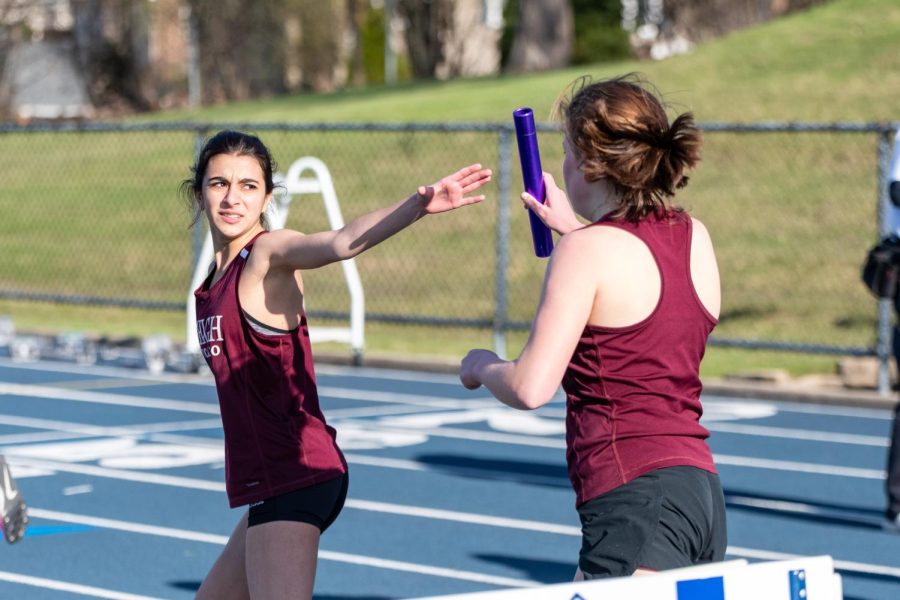Relay team’s close bond catalyzes teamwork, motivation
Sophomore Mary Bridget Molony hands off a baton to senior Maya Mubayi during a relay team race.
April 29, 2022
The sound of fast footsteps fills the air, drowned out by the screams of parents and fans. Not heard, though, are the other runners in the relay. They are quiet and focused, waiting for their turn to take the baton and show up for themselves and their teammates to hit the goals they have set as a team.
The bonds among the runners and the added motivation to run well for their teammates are what catalyze a successful relay team, according to three relay runners.
The difference between relay training and individual training is the focus on baton handoff, according to sophomore Skyler Albert, who runs the 4x800m and occasionally the 4x400m relays
“When you’re done with your turn and you want to give the baton to your teammate, it’s really important to do that as efficiently as possible because every second counts,” Skyler said.
The coach ultimately sets the order of the runners for a relay race, but the runners themselves are involved in the decision-making process through conversations at practice. This order is important. According to Skyler, for example, getting off to a fast start can demoralize opposing teams.
“There’s also planning and strategizing,” Skyler said. “Not physical stuff, but looking at other teams’ times, finding out other teams’ lineups and preparing strategically.”
Skyler said practice is also an opportunity to socialize, which helps form the necessary bond for relay teammates.
“The bond is formed through normal conversation. I might go on a five-mile run with mainly one other person, and that’s like 40 minutes of just talking with somebody, which can be pretty productive and significant,” Skyler said. “A big part is warming up before each race. When you are performing in a relay, you’re warming up with your friends, so you get to talk and do that.”
According to senior Taig Singh, who runs the 4x400m and 4x200m relays, this bond extends beyond the track, with relay teammates meeting up outside of school and talking with each other in group chats.
“Track is generally an individualistic sport, so everyone really runs for themselves and they try to beat their own personal records every time they run a race,” Taig said. “Relays are where you really get the team spirit. Usually there is a strong culture within relay teams.”
This culture is essential for a relay team, according to senior Amanda O’Donnell. She runs the 4x800m and occasionally the 4x400m relays.
“Having a friendship or a strong bond is important,” Amanda said. “Doing a bunch of relays and setting goals together helps strengthen your bond as a team.”
Taig said relays often bring out the best in each runner.
“Given the amount of time you spend with each other in practices and leading up to competitions, everyone does become friends,” Taig said, “and that chemistry really does lead to better running because we push each other harder.”
With teammates relying on him, Taig said he feels more motivation to perform.
“You have more of an incentive and pressure to run well in a relay because not only is your reputation and your pride and your placement dependent on how fast you run, but also that of your three other teammates,” Taig said.
Amanda echoed Taig’s thoughts, adding that the desire to run well for her teammates helps her conquer the mental challenges of the sport.
“Running can be a tough sport mentally. When I’m running for a relay team, I have more motivation to keep going because we’re trying to get this time or qualify for this thing as a team,” Amanda said. “You really want to show up not only for yourself, but for your teammates, and I think that’s super helpful in running faster times and achieving goals.”




























































